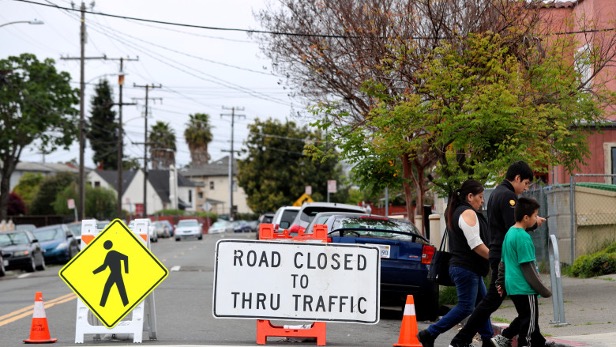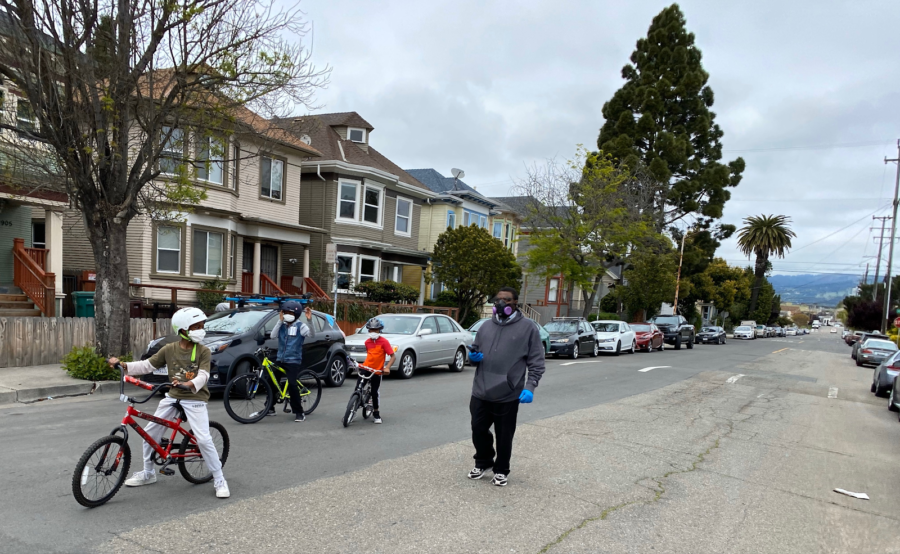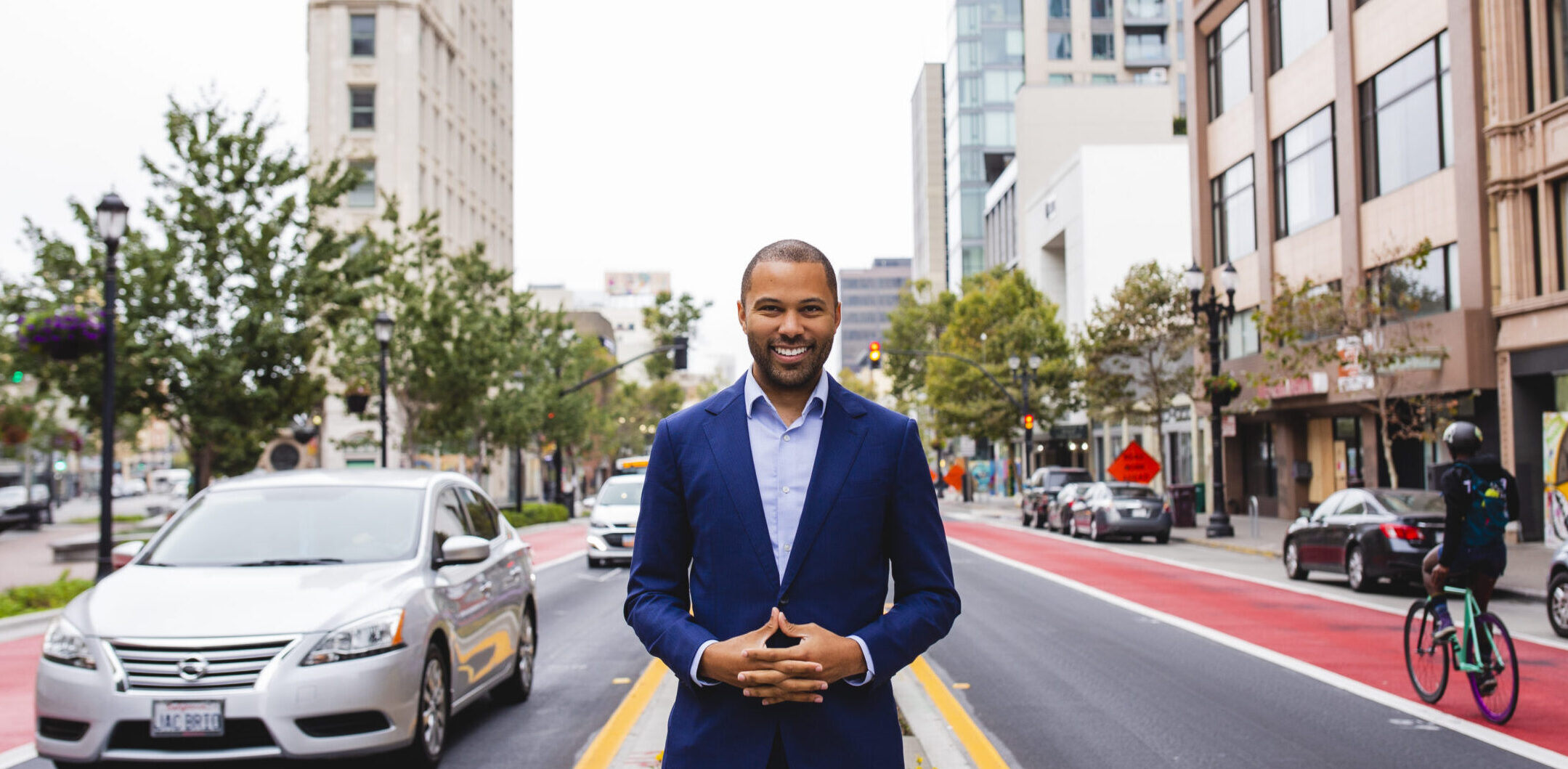14 min read.
Warren Logan serves as the Policy Director of Mobility and Interagency Relations for the Mayor’s Office of Oakland. Warren works closely with the City’s Department of Transportation, Public Works Department and other Bay Area public agencies to develop strategies that advance the city’s vision for safe and sustainable transportation for everyone
What led you to work in cities?
What led me to work in cities is that first and foremost, I live here and I want to improve not only my daily life, but also that of those who look and sound and act like me as well. The other part, and this a running thread behind my entire career, is that I love people. I love meeting new people, understanding what their stories are, what makes us connected both socially and in the case of transportation planning, what connects us physically. I’m interested in how we can reach each other effectively again, figuratively and literally.
Oakland made headlines early in the COVID-19 pandemic for rolling out an extensive network of Slow Streets. Can you talk about the intentions of this program and how you were able to make that happen so rapidly?
First, let’s talk about the intentions. The paramount goal is to always advance safety in our city for people walking, bicycling, and even driving throughout our neighbourhoods. That will always be true, pandemic or otherwise. Secondly, we wanted to respond directly to some of the issues that we were seeing related to the quarantine, and then by extension to the shelter in place policies. One of those was that people who do not have yards or good access to green space were looking for places to let their kids out to play, to walk out and get a little bit of exercise.
Early on in the pandemic, during the first couple of weeks, we saw record numbers of people at Lake Merritt, which is this beautiful lake in downtown Oakland. On one hand, I’m happy that people love our Lake so much. Unfortunately, in the case of a pandemic, gathering all in one spot was not going to be a great option for anybody. Stringing this all together, we wanted to make sure that we were improving people’s health and safety outcomes and that we were providing additional space for people to physically distance, while using a network of streets that were representative of the community’s historic engagement with us.
Last year, which feels like a decade ago now, we had just adopted our Let’s Bike Oakland Bicycle Master Plan. Within that plan, thousands of citizens had shared with us that there are so many people who don’t feel comfortable walking, or bicycling along major streets in the city because of fast-moving traffic. They had said that it would be better or at least more comfortable for them if they had a way to navigate their neighbourhoods, or even perhaps the city through a series of neighbourhood traffic calmed streets, which are by definition in this plan, the neighbourhood bikeways. So we just pulled from that plan to define those 74 miles of streets that were eligible for Slow Streets.
You’ve been very committed to enhancing public participation in urban processes. Could you elaborate on the problematic nature of traditional government engagement with citizens, and how the community engagement in 2019 helped guide your process for Slow Streets?
Let’s begin by talking about what we used to do, and by we, I mean city planners, transportation planners, the “government”. The traditional engagement model is not engagement, it’s outreach, it’s notification. Worst-case scenario, the government will send you a notice saying that in some amount of time, a change is coming. Either your street is being repaved, or we are redesigning your street. We’ve already made the decision, and are just letting you know that it is happening.
The next step towards equitable engagement would be having a town hall where there’s this sort of uncomfortable process during which a government representative would explain what’s happening and ask the community to share an unfiltered, uncategorised opinion about the decision that has already been made. There is only a slight opportunity to adjust thinking and by extension, the decision on the matter.
True engagement requires that you start from the ground up, with a shared understanding of challenges and not just the bad stuff but also the shared joys, what is working right. So often, the starting point of these conversations is what we dislike about our neighbourhood. I don’t think that people like solely talking about the bad stuff in their community. The traditional town hall meeting brings out this rivalrous, animalistic side of us, where it seems like you have to claw to get anything you can. What true engagement can look like is taking people to coffee. You would gather a few people at a time and get to know them over time, as people, and ask them more specifically about the challenge at hand regarding a particular street, park, or neighbourhood.
The bike plan is essentially the core foundation of a lot of our capital improvements. Our staff went to hundreds of public events over a period of about a year and just said, “hi, we’re here to talk to you about your impressions of the city, your impressions of transportation, and about bicycling”. Throughout those conversations, we got to some central themes that had both nothing and everything to do with bicycling in Oakland: themes such as riding a bike, getting access to a bike, and then doing that safely throughout the city. The other part that I think is really important is that we allowed the conversation to go wherever it needed to go. We would do this in part by asking, for example, “when I say bikes, what comes to mind?”. We got answers such as “police, danger, discomfort, and gentrification”. So, there’s a need to talk about that and understand why those connections were made. We want to understand, and then by extension, evaluate how and why that connection was made so that it can inform the policies and practices that are baked into this plan instead of blinding ourselves from those topics.

There was some pushback from certain communities when Slow Streets were rolled out, and initial feedback was non-representative of Oakland’s population. What were some key learnings from this?
We launched Slow Streets central programme almost overnight. The mayor announced it on a Thursday, and we rolled out the first five streets that same Saturday. Admittedly, a lot of people felt a certain way about that. They were in their feelings, they felt betrayed, confused, angry, frustrated, you name it. By Monday the real work began, the real engagement. In the end, all we did was place plastic frames and some orange cones on a few intersections, and you would have thought that a bomb went off.
People wanted the program to be reversed, calling it gentrification, saying we were trying to kick them out of their neighbourhoods. That wasn’t the case, but the fact that we went from 0 to 100 overnight meant that we needed to really unpack a lot of those feelings. In some neighbourhoods, like North Oakland and West Oakland, people thought it was fantastic and expressed that they couldn’t wait for the measures to be made permanent. They asked why we hadn’t done this before and wanted us to expand the program. In East Oakland however, people were frustrated, so we started a working group with a lot of the local advocates that were not necessarily transportation-focused but also health, wellness and so on. It’s not fair that transportation planners go looking just for transportation advocates. Even if you aren’t part of Walk Bike Oakland, you still count. These groups shared with us over the course of several weekly, two hour-long meetings.
The meetings were part venting sessions and part shouting matches at times, and it was clearly expressed that these communities wanted to feel like they were part of the planning process, which is totally fair. There was discontent about the streets we chose, but the irony is that these were groups that a few months ago had told us to make neighbourhood bikeways a programme. My staff was telling me that there was a desire to stop the program, but I refused to believe that the same group of people who just at the beginning of the year were telling me I didn’t move fast enough to prevent deaths on our streets were now telling me that I had moved too quickly.
We finally got to understand that people felt like we should have prioritised connecting people to places and not to nothing. Most of the Slow Streets are just neighbourhood ways that you can do laps in. They told us that many of them were not not working from home so the streets that we had picked were actually ones that they needed to get to major streets in order to go to work or to grocery stores and health clinics. That’s in fact where the Essential Places programme came in.
The iterative nature of the program has been critical to its success – as you just mentioned an ongoing conversation with stakeholders led to the Essential Places Programme. Can you speak a bit about this evolution?
One of the fundamental successes of the engagement, and that iterative process, is that stakeholders would give us a note, we would take that note, and later that week, would implement something. We would repeatedly demonstrate that we were getting the feedback and doing something with it.
We got to a place where a number of people said that the infrastructure that we had put in was misleading, because the barricades were not strong enough to convey the message. Incidentally, we are now upgrading all the signs. The second critique was that Slow Streets weren’t distinguishable enough from any amount of construction in the neighbourhood. So, we are now changing the signs to be community artwork that we hired an artist from East Oakland for that will be printed on a balloon. It’s a cool way to convey the message more strongly.
I think that what we achieved was really powerful. People now have this mentality that this is so temporary that if tomorrow they don’t like it, they can call in, that we will listen, and move that sign somewhere else if needed. People aren’t used to engaging with the government in that way. There’s the magic of this hyper-iterative process. That, to me, is the story that people are missing about Slow Streets, flex streets, shared streets, healthy streets or whatever we want to call them. It’s not whether or not any of these streets are going to be permanent. What is permanent is our approach to design and implementation. The engagement looks like this: “I’m going to talk to you on Wednesday, we’ll change a few things on Saturday, I’ll call you back and see how we did.” Then we’ll let it bake for a few weeks, implement a few needed changes, look at it again, and then maybe in a year, we’ll say “okay, we’ve found a good middle for everybody. All right, drill it in everybody. Now, it’s going to be there for a bit longer.”

This points to the benefits of tactical urbanism, that has a lot to offer in terms of its agility, speed, and relatively low costs. How do you think this programme will help guide the city’s vision of its streetscapes in the future?
So here are some lessons learned that we’re taking in the future. One is about cost and effort. This programme may just cost us about $150,000-200,000 of infrastructure. Basically, just buying cones, over and over again. $200,000 might seem like a lot of money to any individual person, but to a department that manages hundreds of millions of dollars of capital improvements, it’s pennies on the dollar. The fact that we could launch any kind of city-wide programme, and have this much successes and lessons learned, so quickly and with so little money means that there’s something to this.
We need to remember this paradigm. In the future, before we go to apply for a $20 million grant, let’s place some cones in the middle of the street and see how people react and have a conversation about that before we ask communities to imagine that in 10 years, we’re going to completely destroy this road and put something else outright. There needs to be something ahead of time that people can modify. I tweeted out a couple months ago that city planning should be like moving furniture. You don’t talk about moving the couch for two years and then leave it in place forever. You pick it up with your roommates, move it around a bunch and find the best fit for everyone.
One of the things that we’ve started implementing that needs to be made permanent is these long term working groups. Typically governments engage residents and advocates on a project level versus regular check-ins, bringing to people an agenda of things so that they can see the engine constantly moving. I think that’s just a better way of connecting with people. It helps them see the broader vision and feel included.
I know some of the Slow Streets in the city are going really well. Some of the neighbourhoods love them, I have received some pretty adamant emails and written letters. We’re not really sure what permanent even looks like, because there are some city charter rules that make it quite complex. East Oakland neighbourhoods have expressed to us a number of times that Slow Streets all day, every day, may not be what they’re looking for. But weekend streets, when people really are at rest, that’s interesting, right? Parents have also shared with us that during the school year, this may not work, but that in the summer, it would be great for their kids to be able to play outside safely, without needing to be watched. I think it would be really interesting if every summer the city said it would commit $2,000 and some staff time to launch summer streets. That can become a programme that allows kids to connect with their neighbours and neighbourhoods. So really, what is permanent here is the flexibility. I say this jokingly, but literally what is to be made most permanent is our approach to impermanence.
To end on a joyful note: I’ve seen such great photos of kids roller skating in Slow Streets, I’ve seen distanced dance parties, families just enjoying being outside – what are some favourite moments you have witnessed?
I’ll give you maybe two highlights. I was in North Oakland, bicycling around. I stopped and spoke with a couple of neighbours about their daughter and son in this cute little happy family. They were so happy that this programme gave them a little bit of joy during the pandemic. What was also really telling was their surprise, and a lot of people have said this, that at least the city’s responding to them. It feels like we are listening, and that we’re doing something. Even the people who are major detractors of Slow Streets have acknowledged repeatedly that at least we have a weekly meeting where it feels like they are being listened to.
Secondly, I live next to a Slow Street, but maybe not one that would be considered a success. There aren’t kids playing on the street, but the street is really quiet, something that wasn’t the case before. There’s also the fact that there have been no injuries and fatalities on these streets. Statistically, we would have seen far more collisions and injuries and deaths on these very streets. And the fact that we haven’t, is also a win. So sometimes, a little bit of peace and quiet is also representative of success. That’s the other part that I’m especially joyful about. Respectfully, the transportation safety element, during this whole effort has been quite a joy and a success.
That was my last question. But I do want to give you space, if you have any last comments.
I love talking about this programme, I love that our staff have been so flexible again. And I really hope that this just becomes like a toolkit, where you can ask for a Slow Street, or a speed bump, or a stop sign easily. I will say, though, that there is some healing that needs to happen in this city and in many cities across the USA. The fact that people felt like a few A-frames were going to spell disaster and that they would have to be forced out of their neighbourhoods has nothing to do with transportation, and everything to do with affordable housing and economic development. All of these things are connected. The fact that people went to that very dark place in their mind so quickly is something that the transportation department alone cannot address. That is a city level conversation, that we’re going to need to really reconcile. When I say “I want to make your street safer” and your immediate response is questioning if more safety is going to mean that your rent will go up and that you have to then decide between traffic safety or rent, that’s a sign that things are really not okay. So what are we going to do about that?

Header photo by Dorean Raye.

